
All Solutions

Explore all the solutions you can create with Paperform: surveys, quizzes, tests, payment forms, scheduling forms, and a whole lot more.
See all solutions











Connect with over 2,000 popular apps and software to improve productivity and automate workflows
See all integrationsProducts
Solutions
All Solutions

Explore all the solutions you can create with Paperform: surveys, quizzes, tests, payment forms, scheduling forms, and a whole lot more.
See all solutionsIntegrations

Connect with over 2,000 popular apps and software to improve productivity and automate workflows
See all integrationsResources
Why Putting up a Paywall Is the Right Move for Your Content

Whether you should put content behind a paywall is a serious consideration for any online content provider. While they can provide a welcome source of income away from advertisements, paywalls tend to alienate audiences and impact customer retention if they're not implemented carefully.
But despite their drawbacks, paywalls aren't inherently bad. With the right paywall strategy and careful planning, you can set one up that strengthens your relationship with customers, while improving the strength of your brand and adding a source of stable revenue for your business.
In this guide, we'll look at the types of paywall, best practices, and how you can successfully implement one for your own business.
What is a paywall?
Put simply, a paywall is a way to block access to content. It hides media (audio, video or written) behind a digital 'wall' that can only be bypassed after the visitor pays a fee or purchases a subscription.
We've all experienced paywalls on the web. The most obvious example is newspapers, magazines and digital news websites like The Washington Post or The New Yorker, which give access to subscribers only.
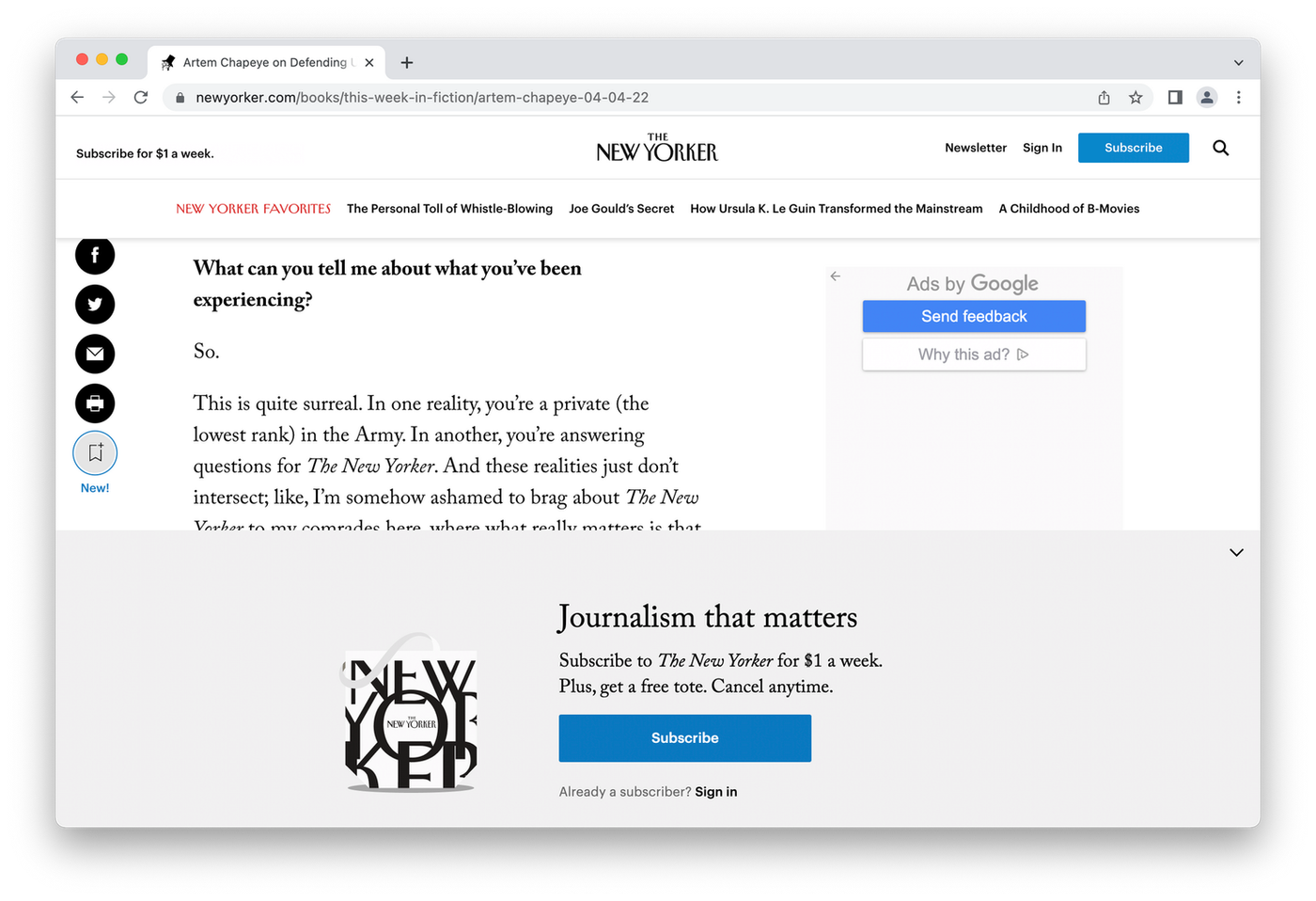 (Image Source: The New Yorker)
(Image Source: The New Yorker)Paywalls began as a byproduct of the shift from print to digital in the mid 2010s. As readers fled traditional newspapers for their online equivalents, ad revenue and paid subscriptions plummeted. Paywalls allowed them to to staying afloat.
Since their inception, paywalls have become a popular business model for digital publishers. They offer an alternative to an advertisement-driven revenue model, freeing up media producers to focus on providing quality for their customer base, rather than producing content that attracts the highest number of clicks.
What can you put behind a paywall?
Digital journalism, content and storytelling remain the most common pieces of media to place behind a paywall. This includes everything from short stories in a literary magazine to news features from The New York Times.
Though it's important to note that paywalls refer to much more than just newspaper articles. A paywall involves restricting access to a page or a download, which means any digital product can be put behind a paywall.
The key? Whatever you hide behind a paywall must be worth paying for. This means, whether it's a podcast, a piece of writing or a video, it must have a certain quality that elevates it beyond everything else in the vast ocean of free internet content.
The different paywall models
Paywalls fall within two distinct categories: hard and soft. Both categories refer to the different levels of access offered, with "soft" paywalls offering more control over how content is distributed and accessed.
Hard paywalls
A hard paywall blocks access to all content on a website until visitors pay. There may be a short summary or teaser available to view, but that's all. This model is rare, with only around 3% of news organisations using it (according to a Reuters Institute poll).
Typically, hard paywalls are only used by high-quality websites with established brands and large audiences, like The Wall Street Journal.
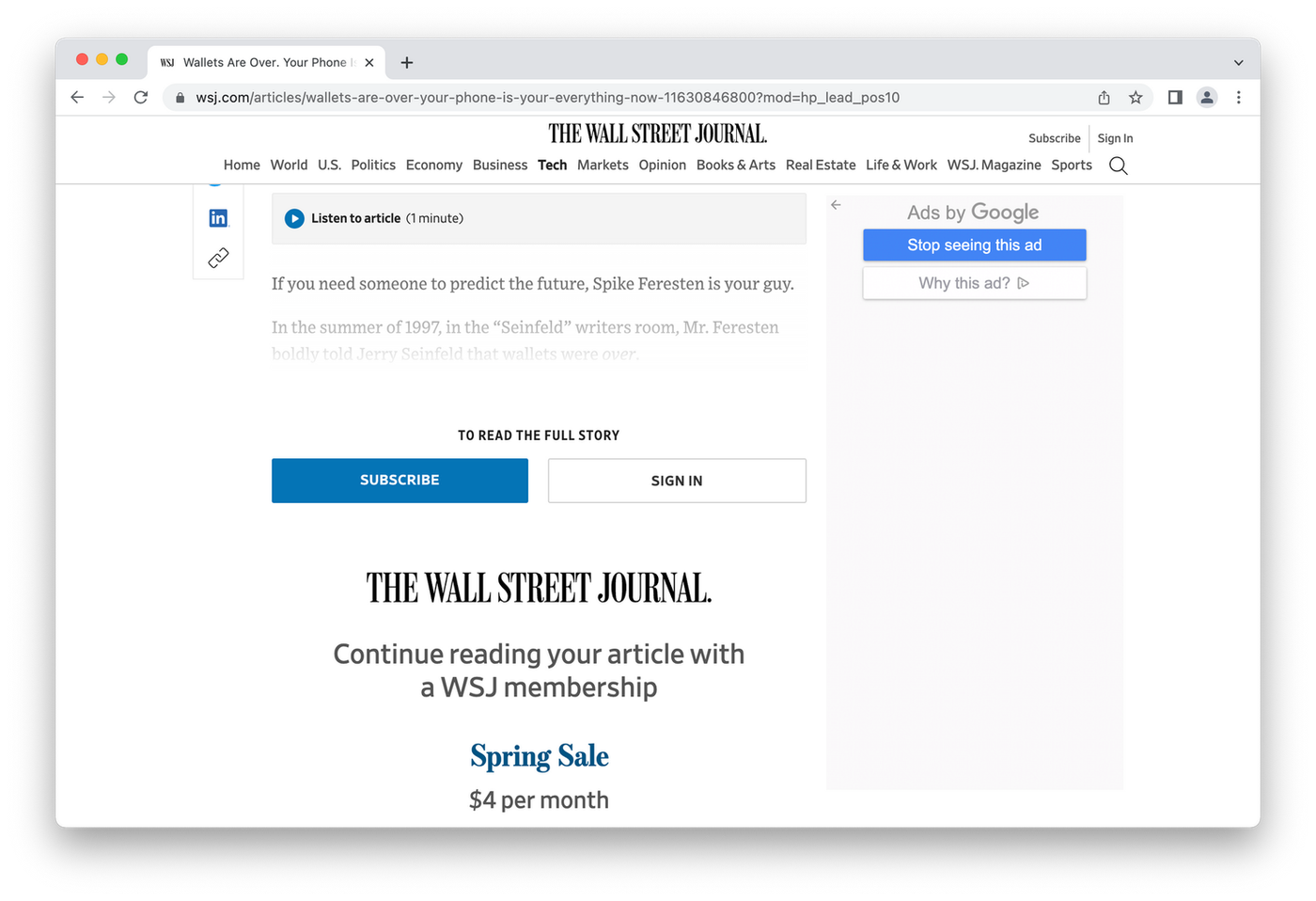 (Image Source: The Wall Street Journal)
(Image Source: The Wall Street Journal)This type of paywall can also be used for selling digital products online. For example, a marketer might offer free blog posts on their website, but keep an ebook locked behind a hard paywall. Hard paywalls are best reserved for your most "premium" content. It has to be worth the money.
Soft paywalls
Soft paywalls (otherwise known as leaky or porous paywalls) are a model that only enforces paid barriers conditionally. They are much less rigid and give you several different options.
There are three main types of soft paywalls:
- Freemium paywalls: The freemium model allows you to grant access to some content while keeping premium material behind a paywall. The idea is to build trust with free content, while enticing users to pay for premium content that provides more value and in-depth information.
- Metered paywalls: With a metered paywall you can give users some content for free, but prompt them to pay once they've hit a predefined ceiling. An example of this type would be an online news site that offers a certain number of free articles before users have to subscribe.
- Dynamic metering paywalls: Technically dynamic metering is a subset of the metered model, but it deserves its own entry. Dynamic metering adjusts the required payment based on the individual user. A script on the website tracks the visitor's usage and customised the offering to their unique habits.
Form a better life now.
The benefits of putting up a paywall
Critics of paywalls claim they run counter to the original intent of the internet. That everything should be free and accessible by anyone. What that view doesn't take into account is that great content takes time and effort to produce.
Content producers of any type—whether it's a huge news corporation or a freelance food writer selling recipes on their portfolio website—should be able to make money from their work without having to rely on clickbait and ads.
And, many people are willing to pay for content they value. Paywalls don't make sense for every business, but if you're considering adding one to your site, there are some pretty sizable benefits to consider.
Higher, more consistent revenue
If you can manage to build a loyal readership that's willing to pay to access your site's content, it can be a huge boost for your bottom line.
No longer will you have to solely rely on advertisements or other income channels. You'll have people who come directly to your business to provide regular, predictable income via a paid subscription model.
Dedicated subscribers can make you more attractive to advertisers and other companies looking for brand collaborations*.* A smaller, loyal community of customers is much more valuable than a random selection of visitors you happen to draw in each month.
For example, after years of decline The New York Times reported a 46% growth in revenue from online subscriptions in 2017 for a total of $360 million. In comparison, they made $238 million from digital advertisements. Paywalled content for the win.
A stronger brand
There is a perception that sites with content behind a paywall tend to be of higher quality than those without one. A paywall tells visitors that what you offer has value beyond other free blogs and websites on the internet.
Of course, it's up to you as a content creator to ensure that the content you offer is worth the cost. If not, you could risk alienating customers and damaging your brand. And fair enough— people don't want to pay a premium for high quality content, and be given something they could find for free elsewhere.
Sports site The Athletic is the prime example of how brands can be build upon quality gated content. The site launched in 2016 as the antithesis of existing sports reporting, promising no ads, no clickbait, and no reliance on corporate sponsors. Just in-depth, original articles written by the best sportswriters in the field.
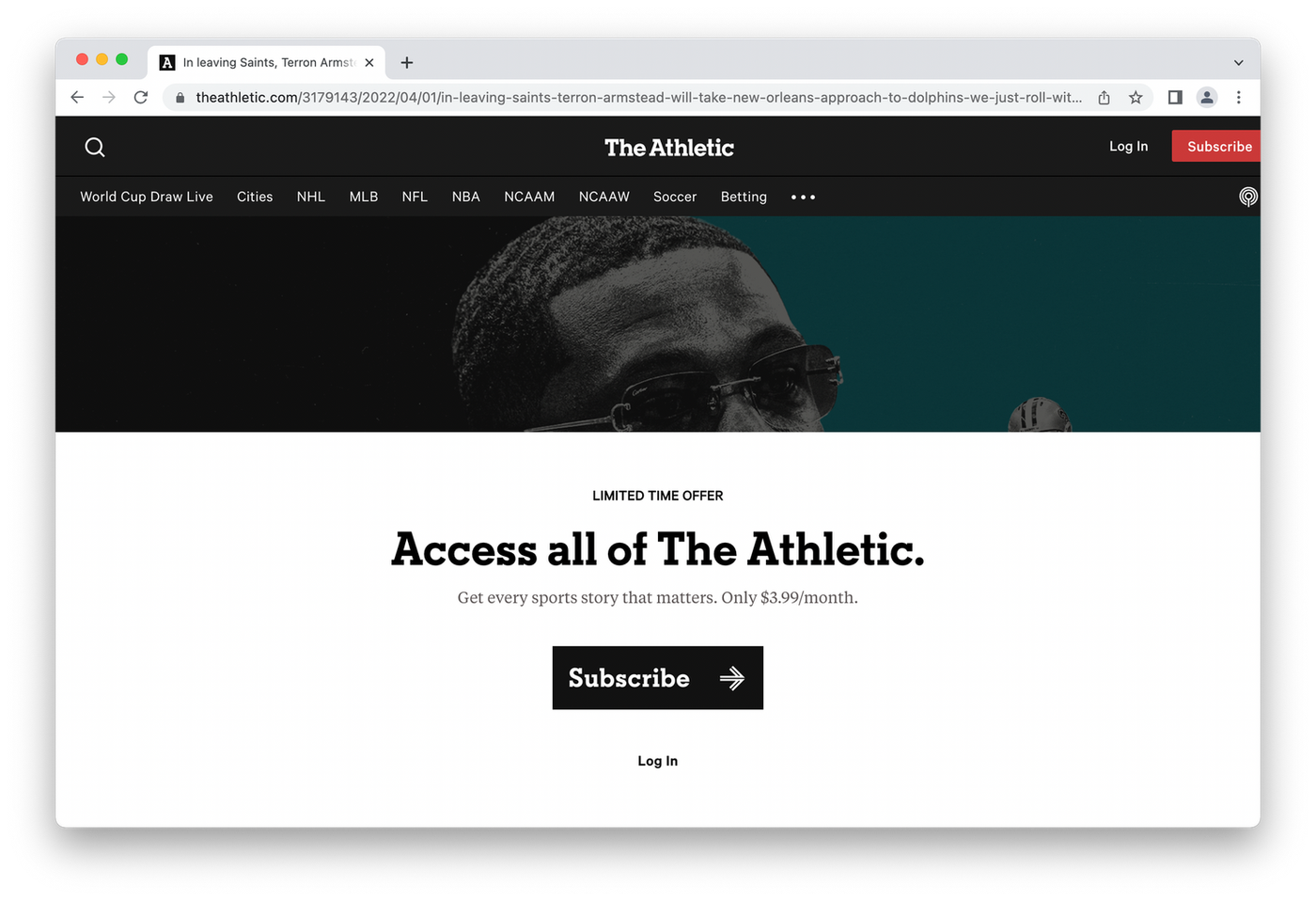 (Image Source: The Athletic)
(Image Source: The Athletic)Without the pressure of generating clicks or meeting arbitrary deadlines, The Athletic’s editorial team is able to create high quality, unique content that people are willing to pay for.
A loyal community
An active group of paying subscribers does more than provide revenue. It creates a community of loyal consumers of your content. The more loyal customers are, the more they are to engage with what you create and spend money with your business.
This idea was explored and popularised by Kevin Kelly, the founding editor of Wired Magazine, in his essay "1,000 True Fans". Kelly's posed that to be a successful creator you don't need millions of dollars, customers or fans—you need just 1,000 'true' fans.
"These diehard fans will drive 200 miles to see you sing," writes Kelly. "They will buy the hardback and paperback and audible versions of your book; they will purchase your next figurine sight unseen; they will pay for the “best-of” DVD version of your free youtube channel."
A paywall indicates that your material is of a unique quality, and can be accessed by only those who are willing to pay for it. This small level of exclusivity can be your ticket to cultivating your 1,000 true fans. Just make sure you're producing worthy content, and start cultivating your community.
Things to know before setting up your paywall
A paywall is undoubtedly useful as both a marketing tool and revenue generator, but hurdles do exist. Knowing what they are before you commit will help determine if a paywall strategy is the right way to go.
1. Understand what your audience wants
Understanding what your audience expects from your content is critical. What specific kind of content are they willing to pay for? Are they of a demographic that has disposable income? Have you already set an expectation that content should be free?
Do some research before you set up a paywall to make sure you don't alienate your existing customer base. The last thing you want is to implement a paywall and lose your core community.
Recognising your customer pain points can be a shortcut to figuring out what content they will pay for. The good news is you don't have to guess—you could distribute a feedback survey to better understand the kind of content they find worthwhile, and what kind they're less interested in.
2. Your content must be worth paying for
We've said it before and we'll say it again. In order to put up a paywall, your content must be worth paying for. You can't just put together a blog post in fifteen minutes, slap a paywall on it, and then expect people to spend to sign up.
If someone offered you a free burger, you wouldn't think much of it. You might take it, since it's free, but you probably wouldn't expect it to be amazing. By the same token, if someone offered you a $25 burger, you would expect it to be the best burger you've ever eaten. That same principle applies for paywalled content.
By putting up a paywall, you're declaring that your content is worth paying for. That means you have to go above and beyond what's out there. What exactly that means depends on the industry you're in, and the kind of content you're creating.
For a journalist it might mean getting unique interviews and doing original research. For a literary magazine, it might mean curating work from writers you can't read anywhere else. Value means different things to different audiences.
3. You may see a decrease in site traffic
Putting up a paywall means you are placing a barrier between consumer and content. Even with an incredible amount of quality content behind that paywall, you could see the traffic to your site drop.
Don't worry. This is a side effect of the '1,000 true fans' theory that we touched on earlier. And if it does happen, you'll be in excellent company.
Major news sites like Bloomberg and The New York Times saw readership decrease after going behind a paywall. But after the initial decline, subscriptions increased and readership numbers stabilised. Ultimately, it provided these publications with a more consistent, reliable stream of revenue. In many cases (as with The New York Times), they ended up earning more than what they drew from advertising alone.
4. Shares of your content may drop
Social media is largely dependent on free, shareable content. A large part of content marketing is ensuring what you produce can be easily shared by readers on sites like Twitter, Reddit or Facebook. Hard paywalls can get in the way of that.
This isn't to say your content is going to be invisible. But because it isn't freely available, people may be less inclined to share it on social media.
If you're using a hard paywall, consider using social media to add value of another kind. Can you share snippets from your articles or videos? Or use these platforms as a way to share your expertise in a new way, like through Instagram live?
It can be a bit of extra work —but just because you're using a paywall doesn't mean your social media loses value. You just need to use it in a different way.
Paywall examples
Paywalls live and die by the execution. The golden rules are to make the payment options clear and the 'wall' itself as unobtrusive as possible. Beyond that, the usual principles of design apply.
We've mentioned a few paywalls in passing throughout this article. But to help give you a clearer idea, we've put together a few paywall examples that are particularly well done.
1. The Financial Times
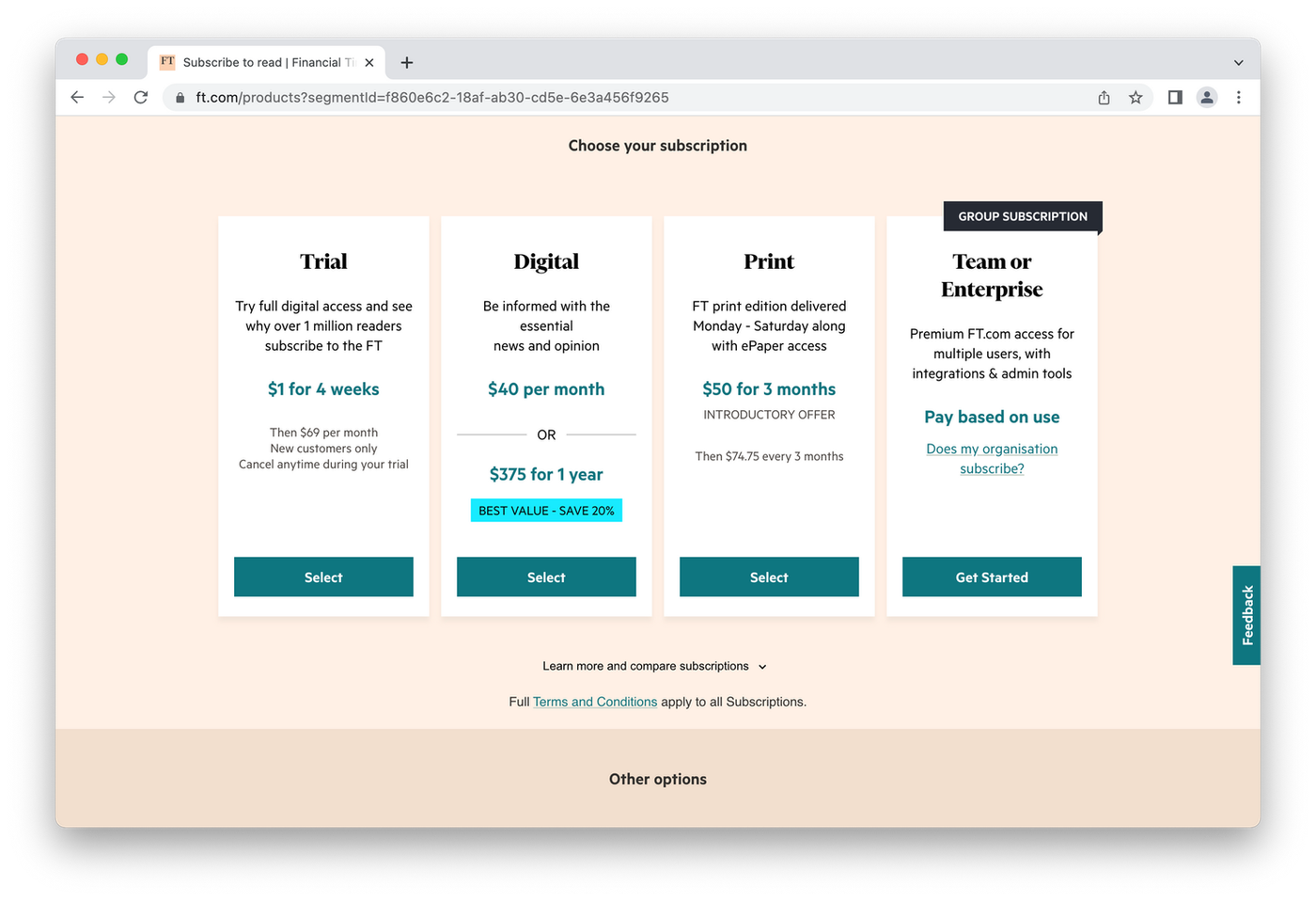 (Image Source: The Financial Times)
(Image Source: The Financial Times)The Financial Times implements a paywall to great success. They reached the milestone of one million paper and digital subscriptions in 2019, which is down to their solid reputation for high-quality journalism.
Their paywall prompts visitors for payment around their seventh visit. By then they have established the user is interested in the content they're providing, and perhaps a good candidate for a subscription.
The Financial Times also offers several pricing options to suit different customers. This increases the accessibility, and allows users to pick a plan that makes the most sense for them.
2. The Athletic
 (Image Source: The Athletic)
(Image Source: The Athletic)The Athletic's pricing page is a great example of a simple, barebones paywall. They offer an annual and a monthly plan, which gives customers choice, but doesn't confuse them with too many options. They also entice customers to subscribe long term by offering a discount for annual membership.
Interestingly, their soft paywall allows visitors to read a sizeable amount of a single article before being cut off (around 200 words). This is a great way to give potential users a true look at the quality of the writing and get them hooked before asking them to subscribe.
3. The Telegraph
 (Image Source: The Telegraph)
(Image Source: The Telegraph)This pop-up on The Telegraph's website asks visitors to subscribe as soon as they reach the site. The UK-based newspaper has a hard paywall, but offers a generous free trial as well as a major discount for new subscribers.
Visitors can also register with their email address for free access for 24 hours. This is a smart tactic to engage with people who may have followed a link on social media, or come across an article on search engines. The emphasis here is on giving visitors a chance to 'try before they buy'.
While this paywall method works for The Telegraph, be wary of using pop-ups like this one too often. They can be annoying for visitors, and can cause them to get frustrated and leave your site rather than sign up.
4. Netflix
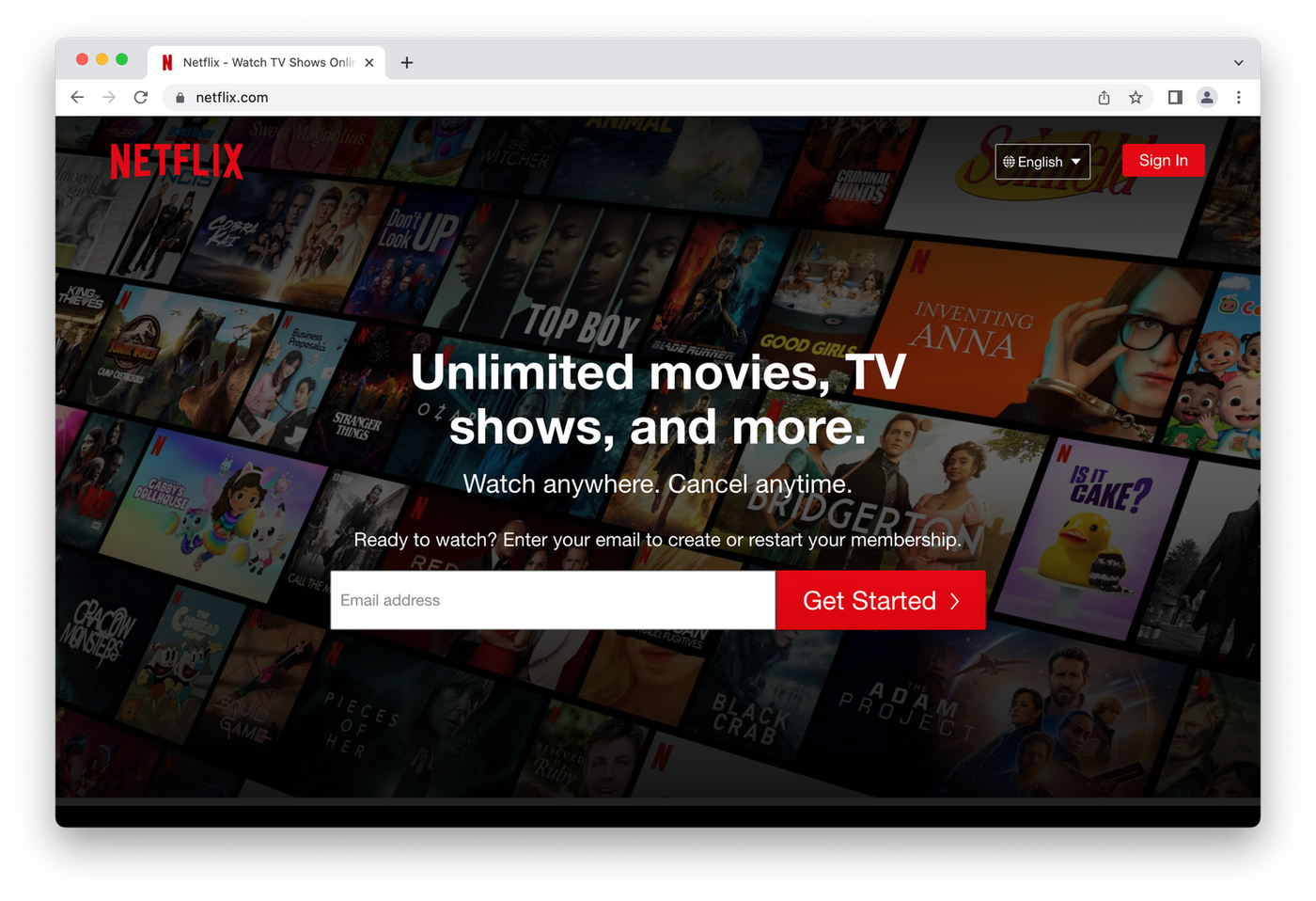 (Image Source: Netflix)
(Image Source: Netflix)You might not think of Netflix and other streaming services as having paywalls (since there aren't really free alternatives) but they certainly do. Netflix has a hard paywall over thousands of movies and TV shows that only subscribing users have access to.
Streaming services are actually an interesting case study of meeting customer needs and creating value. In particular, they're masters of using customer data to ensure they're adding content to the platform that resonates with their core audience.
How can I set up a paywall?
Whether you're selling an ebook, or collecting memberships for a podcast, Paperform empowers you to set up paywalls and start collecting payments in a matter of minutes. You can add a paywall in any of your Paperform creations, whether you create you own or use one of our 650+ unique templates to get started.
Let's say you're selling a book. You can create a form that allows customers to share their email, pay for the book, and have it sent to them automatically using Paperform's advanced question logic. You could embed this form onto any website, or use Paperform to create a functional, gorgeous website of your own.
With our native features you can:
- Capture subscriptions right from Paperform
- Sell products and manage your digital inventory
- Set up memberships, subscriptions and donations
- Automate emails and send paywalled content directly to customers
- Use conditional logic to create dynamic experiences for individual customers
No ugly interfaces. No subscription problems. No commissions to pay to third-party platforms. Just add your digital files or links, connect your favourite payment processor, and starting growing your customer base. Don't have an eye for accounting? That's alright. Receipts and taxes are generated automatically and we don't take extra fees because we think your money is exactly that—your money.
On top of that, we've got more than 3,000 Direct and Zapier integrations so you can connect to your favourite apps and automate the more tedious processes. From Google Sheets to Notion; Mailchimp to Active Campaign; keep track of your subscribers and send data where you need it, when you need it, all without lifting a finger.
Over to you
As a content creator, it can be hard to recognize and quantify the value you bring to the world. When there's so much free content available online, it might feel scary to set your content apart behind a paywall.
But, if you are creating high-quality, unique content that others are willing to pay for, a paywall is a great way to give yourself the credit, recognition, and cash you deserve.
If you are ready to set your content behind a paywall, Paperform's digital suite of tools is a powerful and simple way to do it. We've got the advanced functionalities you need to create a successful paywall, and the sleek, modern design features to make it look however you want. Create a free account today—no credit card required.
Writer
Form a better life now.
Get your 7 day unrestricted trialHere is the ultimate list of online form builders, what they do best, their pricing, and examples to...
Independent retailers are some of the smartest operators in small business—but they’re forced to wor...
Independent retailers are some of the smartest operators in small business—but they’re forced to wor...
Looking for a worthy alternative to Zapier? In this guide, we've reviewed the best automation platfo...